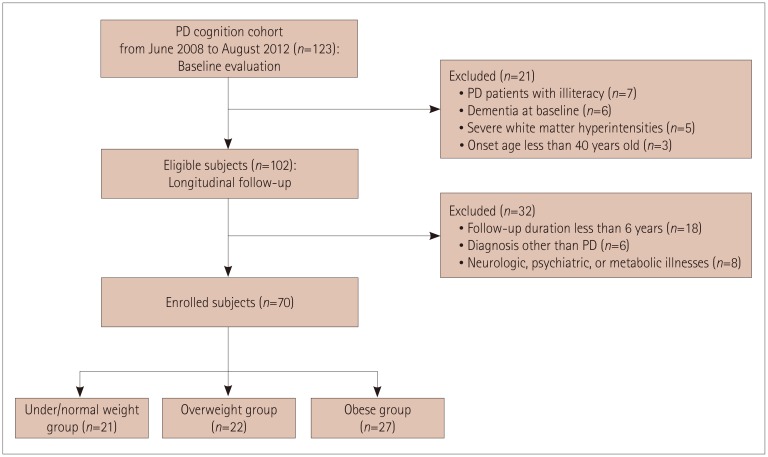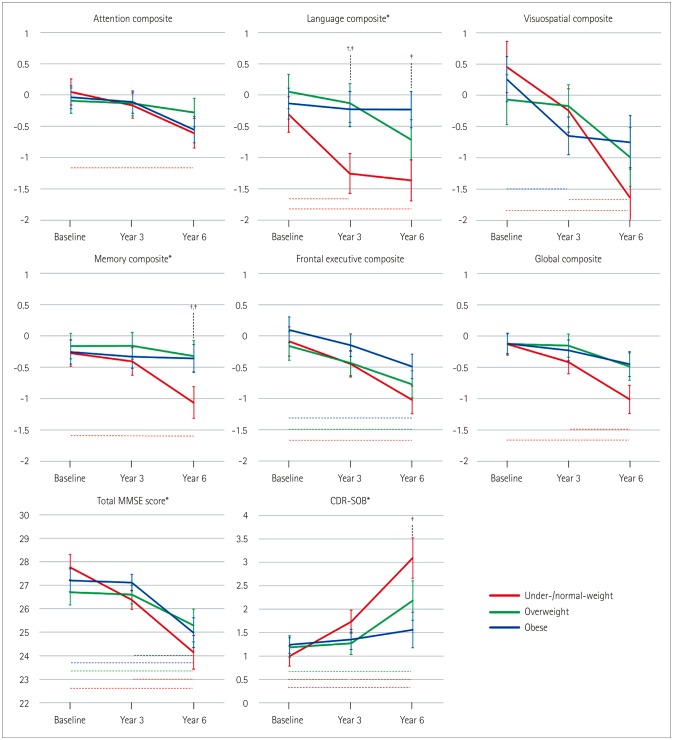J Clin Neurol.
2019 Oct;15(4):517-526. 10.3988/jcn.2019.15.4.517.
The Influence of Body Mass Index at Diagnosis on Cognitive Decline in Parkinson's Disease
- Affiliations
-
- 1Department of Neurology, Yonsei University College of Medicine, Seoul, Korea.
- 2Department of Neurology, Dongtan Sacred Heart Hospital, Hallym University College of Medicine, Hwaseong, Korea. sukyunkang@hanmail.net
- KMID: 2467762
- DOI: http://doi.org/10.3988/jcn.2019.15.4.517
Abstract
- BACKGROUND AND PURPOSE
Associations between alterations in body mass index (BMI) and cognitive function have been reported in Parkinson's disease (PD). We investigated whether the BMI at a PD diagnosis is associated with cognitive decline and the future development of dementia.
METHODS
We recruited 70 patients with de novo PD who underwent neuropsychological testing every 3 years and were followed up for more than 6 years. We classified patients into the following three groups based on their BMI at the diagnosis: under-/normal weight (n=21), overweight (n=22), and obese (n=27). We evaluated differences in the rate of cognitive decline over time among the groups using linear mixed models and the conversion rate to dementia using survival analysis.
RESULTS
The obese patients with PD showed a slower deterioration of global cognitive function as well as language and memory functions than did the under-/normal-weight group during the 6-year follow-up. The three BMI groups showed different rates of conversion to dementia (log-rank test: p=0.026). The combined overweight and obese group showed a lower risk of developing dementia compared with the under-/normal-weight group (hazard ratio= 0.36, 95% CI=0.12-0.82, p=0.046).
CONCLUSIONS
We have demonstrated that a higher-than-normal BMI at the time of a PD diagnosis has a protective effect against the deterioration of cognitive function and the conversion to dementia.
Keyword
MeSH Terms
Figure
Reference
-
1. Van der Marck MA, Dicke HC, Uc EY, Kentin ZH, Borm GF, Bloem BR, et al. Body mass index in Parkinson's disease: a meta-analysis. Parkinsonism Relat Disord. 2012; 18:263–267. PMID: 22100523.
Article2. Aiello M, Eleopra R, Rumiati RI. Body weight and food intake in Parkinson's disease. A review of the association to non-motor symptoms. Appetite. 2015; 84:204–211. PMID: 25453591.
Article3. Morales-Briceño H, Cervantes-Arriaga A, Rodríguez-Violante M, Calleja-Castillo J, Corona T. Overweight is more prevalent in patients with Parkinson's disease. Arq Neuropsiquiatr. 2012; 70:843–846. PMID: 23175195.
Article4. Chen H, Zhang SM, Hernán MA, Willett WC, Ascherio A. Weight loss in Parkinson's disease. Ann Neurol. 2003; 53:676–679. PMID: 12731005.
Article5. Ragonese P, D'Amelio M, Callari G, Di Benedetto N, Palmeri B, Mazzola MA, et al. Body mass index does not change before Parkinson's disease onset. Eur J Neurol. 2008; 15:965–968. PMID: 18637822.
Article6. Vikdahl M, Carlsson M, Linder J, Forsgren L, Håglin L. Weight gain and increased central obesity in the early phase of Parkinson's disease. Clin Nutr. 2014; 33:1132–1139. PMID: 24423747.
Article7. Fitzpatrick AL, Kuller LH, Lopez OL, Diehr P, O'Meara ES, Longstreth WT Jr, et al. Midlife and late-life obesity and the risk of dementia: cardiovascular health study. Arch Neurol. 2009; 66:336–342. PMID: 19273752.
Article8. Cronk BB, Johnson DK, Burns JM. Alzheimer's Disease Neuroimaging Initiative. Body mass index and cognitive decline in mild cognitive impairment. Alzheimer Dis Assoc Disord. 2010; 24:126–130. PMID: 19571736.
Article9. Buchman AS, Wilson RS, Bienias JL, Shah RC, Evans DA, Bennett DA. Change in body mass index and risk of incident Alzheimer disease. Neurology. 2005; 65:892–897. PMID: 16186530.
Article10. Kim HJ, Oh ES, Lee JH, Moon JS, Oh JE, Shin JW, et al. Relationship between changes of body mass index (BMI) and cognitive decline in Parkinson's disease (PD). Arch Gerontol Geriatr. 2012; 55:70–72. PMID: 21763014.
Article11. Lorefält B, Ganowiak W, Pålhagen S, Toss G, Unosson M, Granérus AK. Factors of importance for weight loss in elderly patients with Parkinson's disease. Acta Neurol Scand. 2004; 110:180–187. PMID: 15285776.
Article12. Wills AM, Li R, Pérez A, Ren X, Boyd J. NINDS NET-PD Investigators. Predictors of weight loss in early treated Parkinson's disease from the NET-PD LS-1 cohort. J Neurol. 2017; 264:1746–1753. PMID: 28712000.
Article13. Fazekas F, Chawluk JB, Alavi A, Hurtig HI, Zimmerman RA. MR signal abnormalities at 1.5 T in Alzheimer's dementia and normal aging. AJR Am J Roentgenol. 1987; 149:351–356. PMID: 3496763.
Article14. Gibb WR, Lees AJ. The relevance of the Lewy body to the pathogenesis of idiopathic Parkinson's disease. J Neurol Neurosurg Psychiatry. 1988; 51:745–752. PMID: 2841426.
Article15. WHO Expert Consultation. Appropriate body-mass index for Asian populations and its implications for policy and intervention strategies. Lancet. 2004; 363:157–163. PMID: 14726171.16. Stebbins GT, Goetz CG, Burn DJ, Jankovic J, Khoo TK, Tilley BC. How to identify tremor dominant and postural instability/gait difficulty groups with the movement disorder society unified Parkinson's disease rating scale: comparison with the unified Parkinson's disease rating scale. Mov Disord. 2013; 28:668–670. PMID: 23408503.
Article17. Beck AT, Ward CH, Mendelson M, Mock J, Erbaugh J. An inventory for measuring depression. Arch Gen Psychiatry. 1961; 4:561–571. PMID: 13688369.
Article18. Doty RL, Marcus A, Lee WW. Development of the 12-item Cross-Cultural Smell Identification Test (CC-SIT). Laryngoscope. 1996; 106:353–356. PMID: 8614203.19. Tomlinson CL, Stowe R, Patel S, Rick C, Gray R, Clarke CE. Systematic review of levodopa dose equivalency reporting in Parkinson's disease. Mov Disord. 2010; 25:2649–2653. PMID: 21069833.
Article20. Scheltens P, Leys D, Barkhof F, Huglo D, Weinstein HC, Vermersch P, et al. Atrophy of medial temporal lobes on MRI in “probable” Alzheimer's disease and normal ageing: diagnostic value and neuropsychological correlates. J Neurol Neurosurg Psychiatry. 1992; 55:967–972. PMID: 1431963.
Article21. Ahn HJ, Chin J, Park A, Lee BH, Suh MK, Seo SW, et al. Seoul Neuropsychological Screening Battery-dementia version (SNSB-D): a useful tool for assessing and monitoring cognitive impairments in dementia patients. J Korean Med Sci. 2010; 25:1071–1076. PMID: 20592901.
Article22. Litvan I, Goldman JG, Tröster AI, Schmand BA, Weintraub D, Petersen RC, et al. Diagnostic criteria for mild cognitive impairment in Parkinson's disease: Movement Disorder Society Task Force guidelines. Mov Disord. 2012; 27:349–356. PMID: 22275317.
Article23. Dubois B, Burn D, Goetz C, Aarsland D, Brown RG, Broe GA, et al. Diagnostic procedures for Parkinson's disease dementia: recommendations from the movement disorder society task force. Mov Disord. 2007; 22:2314–2324. PMID: 18098298.
Article24. Hely MA, Reid WG, Adena MA, Halliday GM, Morris JG. The Sydney multicenter study of Parkinson's disease: the inevitability of dementia at 20 years. Mov Disord. 2008; 23:837–844. PMID: 18307261.
Article25. Weintraub S, Wicklund AH, Salmon DP. The neuropsychological profile of Alzheimer disease. Cold Spring Harb Perspect Med. 2012; 2:a006171. PMID: 22474609.
Article26. Langdon DW, Amato MP, Boringa J, Brochet B, Foley F, Fredrikson S, et al. Recommendations for a Brief International Cognitive Assessment for Multiple Sclerosis (BICAMS). Mult Scler. 2012; 18:891–898. PMID: 22190573.
Article27. Gunstad J, Lhotsky A, Wendell CR, Ferrucci L, Zonderman AB. Longitudinal examination of obesity and cognitive function: results from the Baltimore longitudinal study of aging. Neuroepidemiology. 2010; 34:222–229. PMID: 20299802.
Article28. Fedor A, Gunstad J. Higher BMI is associated with reduced cognitive performance in division I athletes. Obes Facts. 2013; 6:185–192. PMID: 23594505.
Article29. Kuo HK, Jones RN, Milberg WP, Tennstedt S, Talbot L, Morris JN, et al. Cognitive function in normal-weight, overweight, and obese older adults: an analysis of the Advanced Cognitive Training for Independent and Vital Elderly cohort. J Am Geriatr Soc. 2006; 54:97–103. PMID: 16420204.
Article30. Gomperts SN, Locascio JJ, Rentz D, Santarlasci A, Marquie M, Johnson KA, et al. Amyloid is linked to cognitive decline in patients with Parkinson disease without dementia. Neurology. 2013; 80:85–91. PMID: 23243071.
Article31. Lashley T, Holton JL, Gray E, Kirkham K, O'Sullivan SS, Hilbig A, et al. Cortical alpha-synuclein load is associated with amyloid-beta plaque burden in a subset of Parkinson's disease patients. Acta Neuropathol. 2008; 115:417–425. PMID: 18185940.32. Weintraub D, Dietz N, Duda JE, Wolk DA, Doshi J, Xie SX, et al. Alzheimer's disease pattern of brain atrophy predicts cognitive decline in Parkinson's disease. Brain. 2012; 135:170–180. PMID: 22108576.
Article33. Buchman AS, Schneider JA, Wilson RS, Bienias JL, Bennett DA. Body mass index in older persons is associated with Alzheimer disease pathology. Neurology. 2006; 67:1949–1954. PMID: 17159099.
Article34. Vidoni ED, Townley RA, Honea RA, Burns JM. Alzheimer's Disease Neuroimaging Initiative. Alzheimer disease biomarkers are associated with body mass index. Neurology. 2011; 77:1913–1920. PMID: 22105948.
Article35. Mashima K, Ito D, Kameyama M, Osada T, Tabuchi H, Nihei Y, et al. Extremely low prevalence of amyloid positron emission tomography positivity in Parkinson's disease without dementia. Eur Neurol. 2017; 77:231–237. PMID: 28285306.
Article36. Winer JR, Maass A, Pressman P, Stiver J, Schonhaut DR, Baker SL, et al. Associations between tau, β-amyloid, and cognition in Parkinson disease. JAMA Neurol. 2018; 75:227–235. PMID: 29228071.
Article37. Pirogovsky-Turk E, Moore RC, Filoteo JV, Litvan I, Song DD, Lessig SL, et al. Neuropsychiatric predictors of cognitive decline in Parkinson disease: a longitudinal study. Am J Geriatr Psychiatry. 2017; 25:279–289. PMID: 27838315.
Article38. Stepkina DA, Zakharov VV, Yakhno NN. Cognitive impairments in progression of Parkinson's disease. Neurosci Behav Physiol. 2010; 40:61–67. PMID: 20012495.
Article39. Jellinger KA, Korczyn AD. Are dementia with Lewy bodies and Parkinson's disease dementia the same disease? BMC Med. 2018; 16:34. PMID: 29510692.
Article40. Yates KF, Sweat V, Yau PL, Turchiano MM, Convit A. Impact of metabolic syndrome on cognition and brain: a selected review of the literature. Arterioscler Thromb Vasc Biol. 2012; 32:2060–2067. PMID: 22895667.41. Shaw ME, Sachdev PS, Abhayaratna W, Anstey KJ, Cherbuin N. Body mass index is associated with cortical thinning with different patterns in mid- and late-life. Int J Obes (Lond). 2018; 42:455–461. PMID: 28993708.
Article42. Calvo D, Gunstad J, Miller LA, Glickman E, Spitznagel MB. Higher serum insulin-like growth factor-1 is associated with better cognitive performance in persons with mild cognitive impairment. Psychogeriatrics. 2013; 13:170–174. PMID: 25913765.
Article43. Atti AR, Palmer K, Volpato S, Winblad B, De Ronchi D, Fratiglioni L. Late-life body mass index and dementia incidence: nine-year follow-up data from the Kungsholmen Project. J Am Geriatr Soc. 2008; 56:111–116. PMID: 18028342.
Article44. Hsu CL, Voss MW, Best JR, Handy TC, Madden K, Bolandzadeh N, et al. Elevated body mass index and maintenance of cognitive function in late life: exploring underlying neural mechanisms. Front Aging Neurosci. 2015; 7:155. PMID: 26347646.
Article45. Kim J, Sharma SV, Park SK. Association between socioeconomic status and obesity in adults: evidence from the 2001 to 2009 Korea national health and nutrition examination survey. J Prev Med Public Health. 2014; 47:94–103. PMID: 24744826.
Article46. Duncan GJ, Magnuson K. Socioeconomic status and cognitive functioning: moving from correlation to causation. Wiley Interdiscip Rev Cogn Sci. 2012; 3:377–386. PMID: 26301469.
Article47. Galobardes B, Shaw M, Lawlor DA, Lynch JW, Davey Smith G. Indicators of socioeconomic position (part 1). J Epidemiol Community Health. 2006; 60:7–12.
Article
- Full Text Links
- Actions
-
Cited
- CITED
-
- Close
- Share
- Similar articles
-
- Radionuclide Imaging of the Neuroanatomical and Neurochemical Substrate of Cognitive Decline in Parkinson’s Disease
- Subjective Cognitive Complaints in Cognitively Normal Patients With Parkinson’s Disease: A Systematic Review
- Reliability and Validity of the Subjective Cognitive Complaints Questionnaire for Parkinson’s Disease (SCCQ-PD)
- Association of Body Mass Index and Cognitive Function in Alzheimer's Disease and Mild Cognitive Impairment
- Visual Hallucinations and Amyloid Deposition in Parkinson's Disease Dementia: A Case Report




